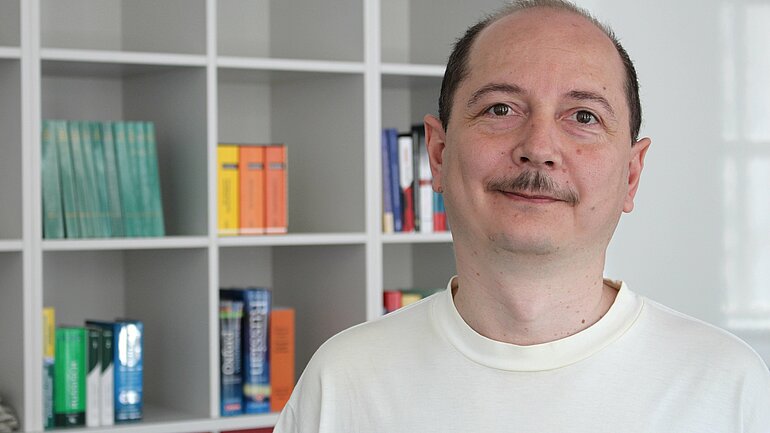"History is important to understand the Ukraine crisis"
Historian Alexandr Osipian examines how historical myths are used in Russian media coverage and propaganda to construct enemy images in the Ukraine crisis. In particular, he focuses on the cultural memory of the Great Patriotic War and on local identities in the Donbas region.

You write that propaganda is most effective when it confirms existing opinions or beliefs. How does that apply to the way the Ukraine crisis is depicted in the Russian media?
In Russian propaganda, the Ukraine crisis is represented as a clash of civilizations, to use Samuel P. Huntington’s term. Russia successfully evokes an image of helping the Russian minority in Ukraine and Russian-speaking Ukrainians against far-right nationalists and corrupt powers operating in Kyiv and western Ukraine. In this view, Ukraine has become the battlefield between a ‘good Russia’ and the ‘bad West’. But for local residents, the myth of the golden age of the Donbas as the most developed and industrialised region of Ukraine, a myth that goes back to the late nineteenth century, is much more significant. It is also important as a symbol: in the Soviet Union, the working-class population of the Donbas was represented as the avant-garde of communist society. The collapse of this system caused a certain crisis of local identity, alongside an economic and social crisis. So in spring 2014, many working-class people expected a new industrial revival by joining Russia. Russia was seen as a supplier of oil and gas and an important market for the machine-building plants in the Donbas.
Yet, the vast majority of residents in the Donbas were not ready to take up arms.
There was a big difference between Russian media coverage, on the one hand, and what locals in eastern Ukraine thought, feared, and expected in spring 2014, on the other. They wanted economic development, but they did not want to fight on either side of the front line. Many of those who are ordinarily defined as ‘pro-Russian’ expected that Russia would annex their province in the same way it annexed Crimea, without any shooting or shelling. Their expectations were quite pragmatic, while the infiltrating Russian nationalists expected armed support in the war against the leading figures of the Euromaidan movement, whom they called ‘fascists’ and ‘neo-Nazis’.
What is the motivation for using this kind of terminology?
In the Soviet Union, the word ‘fascist’ was used as an offensive and pejorative word without any connection to Mussolini’s Italy, where it originates. The term has been used for many decades, even by children, as a synonym for ‘bad people’, so the aim here was to describe the people engaging in the Euromaidan as the principal enemies. In the post-World War II Soviet Union, there was a well-developed memory of the so-called Great Patriotic War. There were many commemorative ceremonies, movies, novels, and articles in newspapers and journals that cultivated a myth of the war, and this myth was deeply embedded in the memories of many generations. Russian propaganda draws heavily on terminology from that historical myth. An example is the expression ‘black uniforms’, which originally described the SS troops of Nazi Germany and was used in 2014 to refer to the Ukrainian National Guard.
Why did this kind of propaganda fall on fertile ground?
Because this ground had been cultivated for many years. The demonisation of political opponents has a long tradition in Ukraine. And from 2004 in particular, history and collective cultural memory were deliberately used as parts of a political strategy. In Ukraine, as in other post-Soviet countries, there’s a lack of political values. Important issues like healthcare, education, or affordable housing are absent from the political agenda. In order to compensate for the lack of ideology, politicians try to convince voters to vote for them by showing that they share the same memory of the past. And they demonstrate that their opponents have a different historical memory and that their heroes were actually the villains. History is important to understand the Ukraine crisis. The main reason is that different parties in the conflict employ different cultural memories – an official narrative representing Ukraine’s history as a constant struggle for independence, and another one going back to the Soviet model of history promoted in today’s Russia. Perception of Ukraine’s past is a matter of painful personal choice for many. Moreover, since 2006 there has been another participant, Russian president Vladimir Putin, who realised how he could use this division in Ukraine to his advantage.
What goal did Putin pursue by bringing up the idea of Novorossiya?
That is a good example of taking a historical myth and using it for propaganda purposes. The Novorossiya Governorate in the lands of present-day south-eastern Ukraine existed only from 1764 to 1802. In 2014, Putin picked up the word ‘Novorossiya’, which hadn’t been used for 100 years. The locals have always identified themselves as people from the Donbas and were very proud of it. Novorossiya was new and unexpected. But that myth was appealing to Russian nationalists in Russia itself. For them, it was like the promised land. For Putin, it was an opportunity to channel these aggressive nationalist forces outside the country to secure stability inside Russia. In doing so, he paved the way for an invasion of eastern Ukraine. Putin used the crisis for his own political purposes.
The interview was conducted by Yvonne Troll, communications coordinator at ZOiS.
Historian Alexandr Osipian is a research fellow at Taras Shevchenko National University of Kyiv, Ukraine, and a former associate professor of history at Kramatorsk Institute of Economics and Humanities in Kramatorsk, Ukraine. From April to June 2017, he is a guest researcher at ZOiS.
Osipian, Alexandr: Historical Myths, Enemy Images and Regional Identity in the Donbass Insurgency, in: Journal of Soviet and Post-Soviet Politics and Society, Vol. 1, No. 1 (2015), pp. 109-140.